
Labrisomids are small blennioids (blennies), percomorph marine fish belonging to the family Labrisomidae. Found mostly in the tropical Atlantic and Pacific Ocean, the family contains about 110 species in 15 genera.
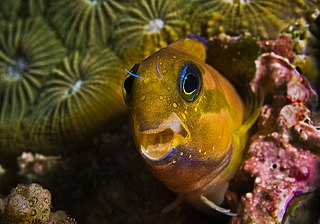
Ecsenius midas, known commonly as the Midas blenny, Persian blenny, lyretail blenny or golden blenny, is a species of marine fish in the family Blenniidae.

Atrosalarias fuscus, also known as the dusky blenny, brown coral blenny or black blenny, is a species of marine fish in the family Blenniidae.
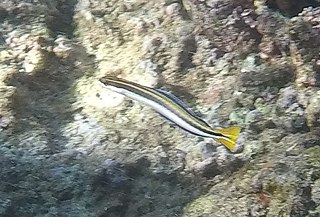
Plagiotremus goslinei, the biting blenny, Gosline's fangblenny, scale-eating blenny or the scale-eating fang blenny, is a species of combtooth blenny found in coral reefs in the eastern central Pacific Ocean. This species reaches a length of 6.3 centimetres (2.5 in) SL. The specific name honours the American ichthyologist William A. Gosline (1915-2002) of the University of Hawai‘i.
Ecsenius bandanus, known commonly as the Banda comb-tooth, Banda clown blenny, or the Banda combtooth-blenny, is a species of combtooth blenny found in coral reefs in the western Pacific ocean.
Ecsenius caeruliventris, known commonly as the bluebelly blenny in Indonesia, is a species of combtooth blenny in the genus Ecsenius. It is a tropical blenny found in the western Pacific ocean, specifically in Sulawesi, Indonesia. Male Ecsenius caeruliventris can reach a maximum length of 2.4 centimetres, while females can reach a maximum length of 2.37 centimetres; it is one of the smallest blennies in Ecsenius. The species name means "sky-blue belly" from the Latin words caeruleus and ventris, referring to the blue abdomen on the species; the common name is derived from this. The species is most similar to its sister taxon E. shirleyae and E. bandanus.

Ecsenius frontalis, known commonly as the smooth-fin blenny in Micronesia, is a species of combtooth blenny in the genus Ecsenius. It is found in coral reefs in the western Indian ocean, in several gulfs in the Red Sea. It can reach a maximum length of 8 centimetres. Blennies in this species primarily feed off of plants, including benthic algae and weeds, and are commercial aquarium fish.
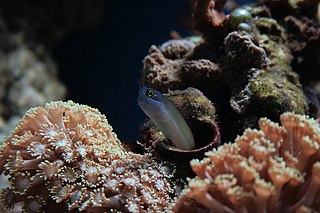
Ecsenius melarchus, known commonly as the yellow-eyed comb-tooth or the Java combtooth-blenny in Indonesia, is a species of combtooth blenny in the genus Ecsenius. It is found in coral reefs in the western Pacific ocean. It can reach a maximum length of 5 centimetres. Blennies in this species primarily feed off of plants, including benthic algae and weeds, and are commercial aquarium fish. The specific name "melarchus" is Latin for "black anus", and refers to the black anal marking on the blennies in this species.

Ecsenius schroederi, known commonly as the Schroeder's combtooth-blenny in Indonesia, is a species of combtooth blenny in the genus Ecsenius. It is found in coral reefs in the western Pacific ocean, specifically in Indonesia. It can reach a maximum length of 7 centimetres. Blennies in this species feed primarily off of plants, including benthic algae and weeds, and are commercial aquarium fish. The species was named in honour of the wildlife artist and scientific illustrator Jack R. Schroeder (1954-2004).

Ecsenius mandibularis, also known as the many-toothed blenny, Queensland combtooth blenny or Queensland blenny in Australia, is a species of combtooth blenny in the genus Ecsenius. It is found in coral reefs in the western Pacific ocean, including the southern edge of the Great Barrier Reef. It can reach a maximum length of 7.5 centimetres. Blennies in this species feed primarily off of plants, including benthic algae and weeds.
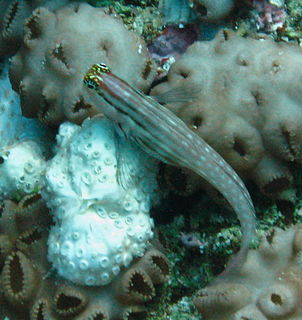
Ecsenius nalolo, known commonly as the Nalolo in South Africa or the Nalolo blenny in Micronesia, is a species of combtooth blenny in the genus Ecsenius. It is found in coral reefs in the western Indian ocean. It can reach a maximum length of 6.5 centimetres. Blennies in this species feed primarily on plants, including benthic algae and weeds.
Ecsenius oculus, known commonly in Micronesia as the ocular blenny and as the coral blenny on Christmas Island, is a species of combtooth blenny in the genus Ecsenius. It is found in coral reefs in the western Pacific ocean. It can reach a maximum length of 7 centimetres. Blennies in this species feed primarily off of plants, including benthic algae and weeds, and are commercial aquarium fish.
Ecsenius polystictus, known commonly as the dotted coralblenny or Andaman combtooth-blenny, is a species of combtooth blenny in the genus Ecsenius. It is found in the eastern Indian ocean, around Indonesia. It can reach a maximum length of 4 centimetres. Blennies in this species feed primarily off of plants, including benthic algae and weeds.
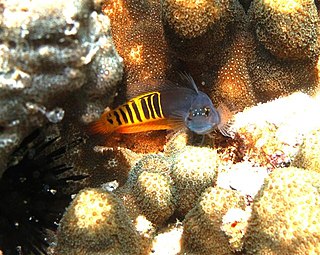
Ecsenius pulcher, the Gulf blenny, is a species of combtooth blenny in the genus Ecsenius. It is found in the western Indian Ocean. Blennies in this species feed primarily off of plants, including benthic algae and weeds.
Ecsenius sellifer, known commonly as the saddle blenny in Guam, or the saddle clown blenny in Micronesia, is a species of combtooth blenny in the genus Ecsenius. It is found in coral reefs in the western Pacific ocean. It can reach a maximum length of 4.1 centimetres. Blennies in this species feed primarily off of plants, including benthic algae and weeds.
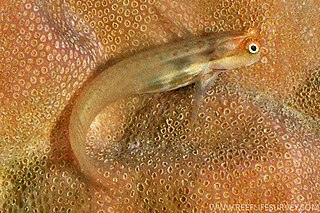
Ecsenius stictus, known commonly as the Great Barrier Reef blenny, is a species of combtooth blenny in the genus Ecsenius. It is found in the Great Barrier Reef, and around the Chesterfield Islands. It can reach a maximum length of 5.8 centimetres. Blennies in this species feed primarily off of plants, including benthic algae and weeds.

Ecsenius yaeyamaensis, known commonly as the Yaeyama blenny in Guam and Micronesia, and also known as the Yaeyama clown blenny in Micronesia, or the Pale-spotted combtooth-blenny in Indonesia is a species of combtooth blenny in the genus Ecsenius. It is found in coral reefs in the western Pacific and Indian oceans. It can reach a maximum length of 6 centimetres. Blennies in this species feed primarily off of plants, including benthic algae and weeds,< and are commercial aquarium fish.
Brockius nigricinctus, the spotcheek blenny, is a species of labrisomid blenny native to the western Atlantic Ocean from south Florida to Brazil. This species inhabits coral reefs or rocky areas from very shallow waters to a depth of 10 metres (33 ft). It can reach a length of 8 centimetres (3.1 in) TL. This species can also be found in the aquarium trade.
Brockis striatus, the Green blenny, is a species of labrisomid blenny native to the Pacific coast of Mexico where it is found in shallow waters with a rocky substrate and substantial weed growth. This species can reach a length of 6 centimetres (2.4 in) TL.
Brockius is a genus of labrisomid from the waters of the eastern Pacific and the western Atlantic where they are associated with reefs and weed covered rocks.












